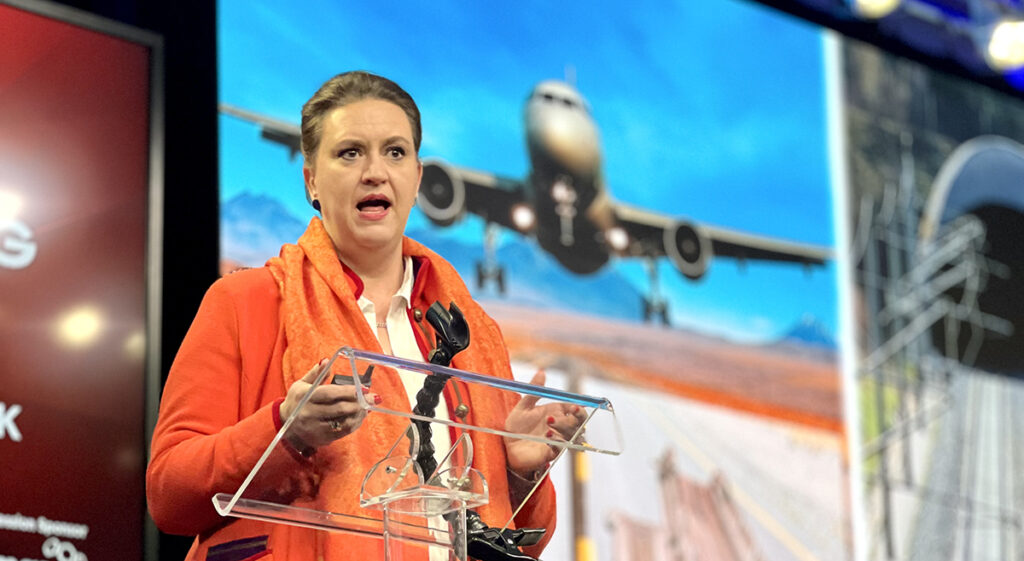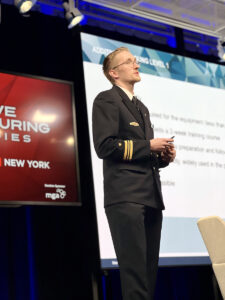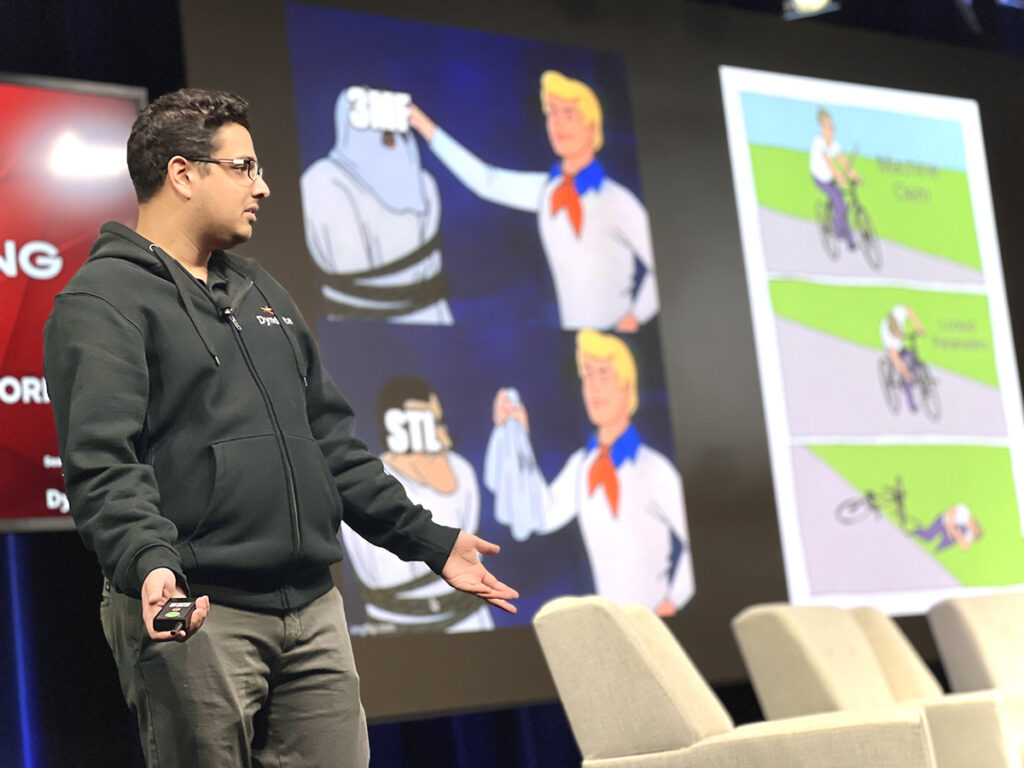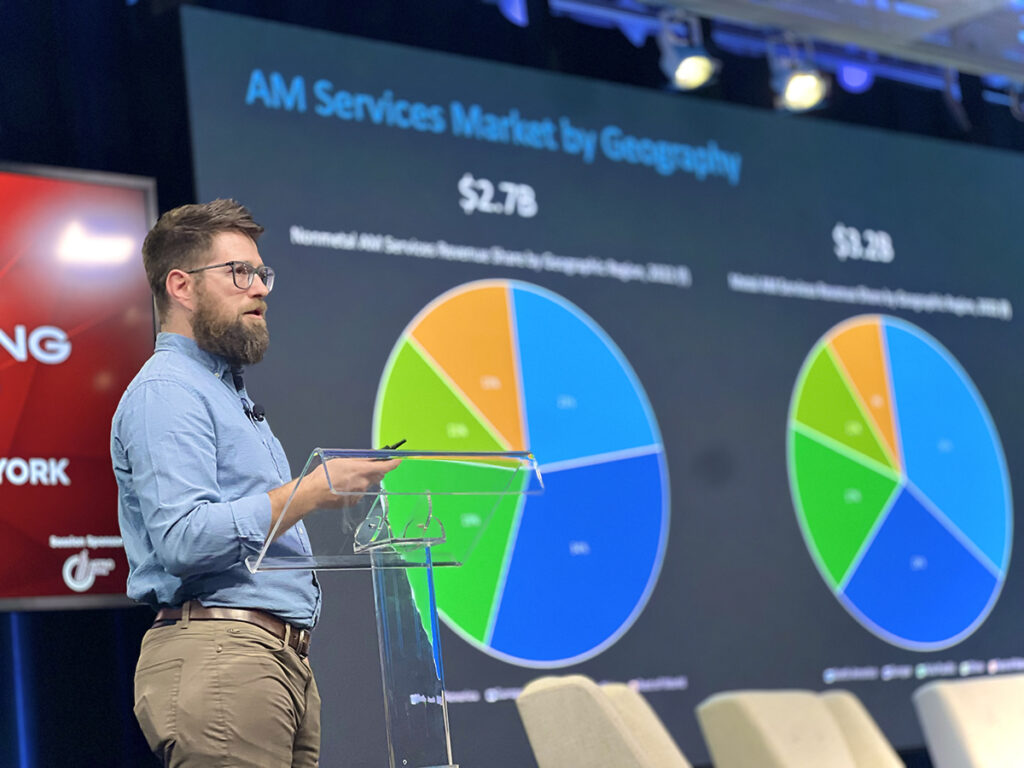AMS 2023 Puts Unique Business Spin on 3D Printing Trade Shows
For its sixth year, New York City’s only 3D printing trade show, Additive Manufacturing Strategies (AMS), returned in full force. The event continues to exhibit increased influence, maturity, and expertise with every iteration. This time, there were several new additions that point in the direction to which AMS is trending, which, in a word, is additive manufacturing (AM) business and networking.
A German Influence
Interestingly, AMS 2023 demonstrated a uniquely German influence due to the participation of major 3D printing players. This included the industry’s leading venture capital fund, AM Ventures, the immensely important consortium Mobility/Medical Goes Additive (MGA), and Additive Manufacturing Berlin (AMBER), a 3D printing-specific initiative run by Berlin Partner.
 Stefanie Brickwede, managing director of MGA. Image courtesy of Ashley Alleyne.
Stefanie Brickwede, managing director of MGA. Image courtesy of Ashley Alleyne.As a result, not only were attendees treated to Bavarian beer and pretzels, sponsored by AM Ventures, on the first night of the event, but they were exposed to the massive role that Germany is playing in the AM ecosystem. AM Ventures’ Arno Held and Alexander Schmoeckel donned lederhosen to participate at the show, including an investment panel discussed in more detail here. Additionally, February 8 was capped on either end by presentations from Berlin Partner in the morning and MGA for the day’s final session on transportation.
MGA and the associated transportation panels showcased how 3D printing is and will continue play a role in every vehicle that gets humanity and its stuff from Point A to Points B – Z. As a consortium, in part led by the German rail company Deutsche Bahn, MGA has been able to more quickly integrate AM into European train infrastructure than would otherwise be possible.
It has tapped all of the key players in this industry to see more than 50 3D printing technologies deployed for use in rail, though Stefanie Brickwede, managing director of MGA, highlighted four as the most important. They included metal powder bed fusion (PBF) and directed energy deposition, as well as polymer extrusion and binder jet (HP’s Multi Jet Fusion). Interestingly, she said that Xerox’s ElemX platform seemed to be an ideal candidate for her company’s use and expressed disappointment at the liquidation of the Elem Additive division. Is there a chance that Deutsche Bahn could acquire the remnants of ElemX? It would seem unlikely, but there could be an MGA partner, like Siemens, that might benefit from bringing it into the fold.
 Lieutenant Commander Sascha Hartig. Image courtesy of Ashley Alleyne.
Lieutenant Commander Sascha Hartig. Image courtesy of Ashley Alleyne.In the case of AMS, transportation also included the aerospace, space, and marine sectors, where Russ Cochran from Boeing, Paul Gradl from NASA, and Lieutenant Commander Sascha Hartig from the Germany Navy, provided talks on how 3D printing is making its way into their segments. In the case of Principal Engineer Gradl, this meant not only the successes of 3D printing metal rocket engines, but also the failures, which can prove to be more educational than the successes. From AM’s overall developmental guidance by the aerospace industry, it wasn’t hard to imagine how Boeing was using the technology, but it was interesting to note just how thorough that use has become since it began using polymer AM in 1988 and metal AM in 1998.
However, Hartig’s presentation framed the military use of 3D printing in a very easy-to-understand and concise manner. Though some didn’t anticipate that the Lieutenant Colonel would be so funny, it was actually the information he provided that was the real highlight of the lecture, if not the entire event. Essentially, Hartig explained just how the Navy is using 3D printing in a manner that moves from comparatively simple and easy to perform on-ship to more complex and necessary to perform off-ship with a production partner. In that vein, he offered the parameters under which a system might make its way onto a naval vessel, including a compact size of less than 1m x 1m x 1.8m, the ability to train on it in about two weeks, low effort in terms of pre- and post-processing.
Of course, Germany has and will continue to have a key place in the AM industry. However, I think that the influence of this nation’s businesses on AMS will only convince other localities to increase their presence at the event. Regional influencers like NAMIC in Singapore, for instance, will want to ensure that the city-state’s impressive AM ecosystem is represented. The exhibition of Italy’s Caracol may drive more Italian firms to take part. Israeli businesses may feel as though they are not utilizing AMS to their benefit.
Intimate Gathering
It was noted by multiple attendees that, though the exhibition space of AMS didn’t compare in size to RAPID, IMTS, or Formnext, the intimate nature of the event offered the ideal opportunities for networking. As a writer, this meant the ability to calmly speak to exhibitors for long periods of time and understand their technologies in greater depth.
Had I been harassed by crowds of passersby, as at larger events, it would have been difficult to understand exactly how New York-based Tecnica developed a method for improving the quality, repeatability, and accuracy of PBF through a proprietary mirror system. I wouldn’t have been able to ask Richard Neill, CEO of Advanced Printed Electronic Solutions, the nuances of his business relationship with Neotech AMT to offer electronics 3D printing as a service. I’m hoping to cover both of those companies in greater depth in follow-up articles.
However, as with all trade shows, attendees didn’t go to AMS to be interviewed by the press. That is obviously a marketing benefit, which was strengthened by the inclusion of media outside of 3DPrint.com, including Davide Sher’s 3D Printing Media Network and ASME’s AdditiveManufacturing.com.
 Dyndrite CEO Harshil Goel. Image courtesy of Ashley Alleyne.
Dyndrite CEO Harshil Goel. Image courtesy of Ashley Alleyne.In addition to gaining knowledge from AM presentations, people go to AMS to network. This not only means linking understanding of the industry through the sharing of information. It also means doing business. There were varied groups of participants moving off into meeting rooms to wheel and deal.
Camaraderie at AMS
Business was additionally taken beyond the quiet meeting rooms to the local nightlife scene. At the rooftop bar of INK48 hotel, a cloister of German attendees mixed and mingled with event participants over IPAs and cocktails to relieve the day’s pressure and take in the glowing skyscrapers of the Big Apple.
 Women in 3D Printing’s Happy Hour event. Image courtesy of Sarah Saunders.
Women in 3D Printing’s Happy Hour event. Image courtesy of Sarah Saunders.At Women in 3D Printing’s well-received happy hour, there was a sense of glamor associated with the sponsorship of CadBlu, Estee Lauder Companies, PicoSolutions, Ultimaker, nTopology, Inkbit, and Shapeways. As with 2022, the event was deemed one of the highlights of AMS. Only this year, the ante was raised, as a music video for Missy Elliot, Queen Latifah, and LL Cool J was filmed two floors below and attendees were able to glimpse into the extravagance of the New York City elite. It’s been reported that some attendees even mingled with illustrious crew.
This energy was palpable throughout much of AMS, with the show bringing in even more thought leaders from the 3D printing industry. In that way, it didn’t feel like a simple reiteration of existing trade shows, but a uniquely New York one where business is done, fun is had, and AM is driven forward.
 SmarTech Analysis Executive Vice President of Research Scott Dunham. Image courtesy of Ashley Alleyne.
SmarTech Analysis Executive Vice President of Research Scott Dunham. Image courtesy of Ashley Alleyne.If one were to apply a SmarTech Analysis approach to compare the year-over-year growth of the event from 2022 to 2023, one would find the typical 45-degree market research angle of destiny. This upward arrow would tell you that not only was this year’s event a bigger success than the preceding year, but that 2024 will only be better. Going along with that, it will be better according to a clear trend: even higher quality business, networking, and market intelligence.
Feature image courtesy of Ashley Alleyne.
Subscribe to Our Email Newsletter
Stay up-to-date on all the latest news from the 3D printing industry and receive information and offers from third party vendors.
Print Services
You May Also Like
3D Printing Grows to $15.9B in 2024 Amid Shifting Industry Dynamics
The global additive manufacturing (AM) market reached $15.9 billion in calendar year 2024, according to “Q4 2024 3DP/AM Market Data and Forecast” from Additive Manufacturing Research (AM Research). Despite a...
3DPOD 247: LJ Holmes, Executive Director for the Center of Advanced Manufacturing and Materials at Harrisburg University
Executive Director for the Center of Advanced Manufacturing and Materials at Harrisburg University, Larry “LJ” Holmes is a pioneer in applying additive manufacturing to defense and other critical sectors. Part...
Thai Startup OsseoLabs to Cut Surgery Time with 3D Printed Magnesium Implants
A patient undergoing mandibular reconstructive surgery typically faces two separate operations: one to place a custom-fit titanium plate and another month later to remove it. But what if that second...
Japanese Advanced Manufacturing Capabilities Grow in Europe with Sodick’s Purchase of Prima Additive
The global economy is currently undergoing a reshuffling in terms of what gets manufactured where. In large part, this trend is being driven by new geopolitical alliances and the need...

























